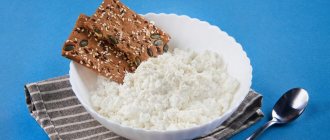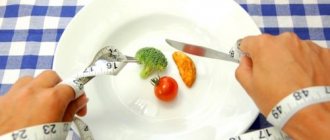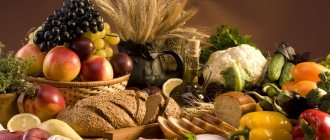How do you understand the term “low carb”?
It's worth understanding what carbohydrates are and how to avoid them. A “low carb” diet will look different to different people. In most general terms, however, a low-carb diet means that you only get about 20 to 30 percent of your daily calories from carbohydrates—such as added sugars, grains, fruits or starchy vegetables. This is usually around 50-100 grams or less. In some cases, for example, if a person is following an LCHF (low carb, high fat) or ketogenic diet, which is also a low-carb diet, he may consume even fewer carbohydrates, about 20-50 grams per day, in order to enter a state of ketosis (a condition in which fat is burned instead of glucose/carbohydrates to produce energy).
If you set a goal to consume about 100 grams of net carbs per day, divide it between three main meals, with 30-35 grams of net carbs in each. What are net carbs? This is the amount of carbohydrates obtained after subtracting the weight of fiber from the total amount of carbohydrates.
In other words, fiber doesn't count toward your total because it isn't actually digested and doesn't affect your blood sugar like glucose does. For this reason, most people, even on a very low-carb diet, still try to consume fiber-rich foods such as non-starchy vegetables and the occasional nut/seed.
Even those on a very low-carb/ketogenic (with a daily carbohydrate intake of about 20-30 grams or less) diet can still eat any non-starchy vegetables, as they are high in fiber, high in water and nutrients, highly filling and very filling. few calories.
What would a low carb meal look like with 30-35 grams of net carbs?
One meal on a low-carb diet may include the following:
An 85-gram serving of protein (such as chicken breast), 2 cups of non-starchy vegetables such as broccoli and peppers, a salad of assorted greens tossed with 1 to 2 tablespoons of oil or dressing. All of this will contain less than 35 grams of pure carbohydrates. If you replace vegetables with starchy ones, say, beets or turnips, you would get more carbohydrates, but not much. For a meal to be considered moderate or high carbohydrate, you would need to add cereals, fruits, sweeteners like honey or potatoes - and this is 20-25 (or more) grams per serving.
- Lettuce leaves or something green and decorative, such as cabbage, on which vegetables with chopped chicken, sprinkled with sesame seeds, are laid out.
- Fajitas with any protein of your choice and lots of vegetables
- Chicken or salmon burgers
- Empanadas or quesadillas made from almond and coconut flour with farm-raised beef and cheese
- Cabbage-based pizza
- And many other options, like smoothies, casseroles and slow cooker dishes
Negative calorie foods
There is a common myth on the Internet that there are foods with negative calories. They actually have a certain amount of calories, but they require more energy to digest. Therefore, “negative calorie” is more of a convenient phrase. In fact, these are low-calorie foods.
The body spends about 10% of all calories consumed per day on digesting food. This figure can change either up or down. Some foods require little energy to digest, while others require more energy from the body to process.
For example, one slice of cucumber contains 10 calories. And it takes 12 calories to digest it. In total, the body will lose 2 calories. This is not enough for weight loss, but if you add foods to your daily diet, digestion will improve due to the high fiber content.
Healthy and harmful low-carb foods
You may be wondering what contains carbohydrates and what does not. Let's be clear: Even if a food or dish is low in carbs, that doesn't mean it's a healthy food! In many cases, the quality of carbohydrates you eat is more important than the quantity. I recommend staying away from packaged low-carb foods, such as most store-bought protein bars or quick snacks, to avoid processed or synthetic ingredients in your diet. Yes, they will provide you with fats and protein, yes, they are low in carbohydrates, but on a global scale they are still harmful because they contain processed protein powders, refined oils and artificial sweeteners.
If you're wondering what to take with you for a quick snack on the run, it's best to make your own. You can make low-carb snacks at home using ingredients like nuts, seeds, humus, coconut flour and coconut oil, protein powder (whey or bone broth), oatmeal and cocoa powder energy bites, kale sprouts, and even low-carb ones. sweets” like cookies, muffins or donuts. The quickest way to do this is to make a low-carb protein shake.
As you look to clean up your diet and embrace new low-carb recipes, you'll also want to get rid of "diet" or "comfort" foods that contain low-fat artificial ingredients. To achieve lower fat content, these products typically use more flour or carbohydrates, thickeners, emulsifiers or artificial sweeteners. And although they may not have much carbohydrates or cane sugar, I would still avoid foods with trans fats or hydrogenated oils, because in essence they are the same fast food or shelf-stable food.
What about starchy vegetables, beans and fruits: can they be used in diet dishes?
If you're having trouble remembering which vegetables are starchy and therefore high in carbohydrates, here are some simple clues:
- Most vegetables grown above ground are considered "non-starchy" and therefore contain fewer carbohydrates (such as cruciferous vegetables such as broccoli, leafy greens, peppers, chard and kale). Some squashes are also considered non-starchy, including spaghetti squash and zucchini. Vegetables that grow underground, also called “root vegetables,” are usually richer in starch and carbohydrates (eg potatoes, carrots, turnips, beets).
- This is not an ironclad rule. For example, regular pumpkins grow above the ground and are high in carbohydrates, but you can use these traits as a starting point.
While most root vegetables and fruits are not generally considered “low carb,” many are still nutrient-dense, low in sugar, and make a good addition to any diet. In fact, strained, crushed or pureed vegetables and fruits can in many cases serve as substitutes for sweeteners or even cereals. A good example is shredded cauliflower.
The same applies to legumes or legumes, for example, chickpeas can be made into flour or hummus, and then they make an excellent spreadable side dish that goes well with many low-carb dishes. These foods are rich in antioxidants, provide you with essential fiber, and make your food sweeter, which helps overcome the addiction of sugar, which allows you to avoid adding it to your food separately. For this reason, I recommend including the following fruits and starchy vegetables in your diet:
- Berries – such as strawberries, blackberries, blueberries or raspberries
- Cherry
- Cranberry
- Kiwi
- Citrus
- Melon
- Sweet or purple potatoes
- Swede
- Beet
- Celery
- Parsnip
Legumes and legumes - such as chickpeas, black beans, mung beans, adzuki, etc. They are also not considered low-carb foods, but are healthy foods in moderation. If you decide to include legumes or grains in your diet, I recommend pre-soaking and sprouting them before cooking. This helps release more protein, vitamins and minerals and makes them more easily digestible.
Foods containing 30–35 grams of net carbs
Nutritionists recommend following examples of low-carbohydrate eating:
- About 90 g of protein. As the main element, you can take chicken breast in combination with 500 g of non-starchy vegetables. The latter includes broccoli, bell peppers, mixed greens and 1-2 tablespoons of olive oil. The dish as a whole contains less than 35 g of pure saccharides. If you replace poultry with vegetarian starch (beets or turnips), the amount of saccharides in food will increase. However, their quantity will not reach 50 g. To increase the amount of carbohydrates in the dish, it is recommended to add honey or potatoes. They contain 20–25 grams of saccharides per serving.
- Lettuce cups filled with vegetables and some sesame seeds or shredded chicken breast. The latter should be steamed or boiled.
- Fajitas, with a high protein content to taste and a lot of vegetables.
- Sandwiches made from lettuce and boiled chicken breast.
- Empanadas or quesadillas are dishes filled with beef, cheese, herbs, and topped with almond or coconut flour.
- Boiled cauliflower pizza.
To increase the digestibility of low-carbohydrate dishes, it is recommended to make cocktails and casseroles from the products.
Low-carb diet: an overview of the benefits and how it works
Plenty of research shows that for those who make consistent efforts, a low-carb diet is highly beneficial. It's not always necessary to give up all unprocessed, whole sources of carbohydrates (such as the fruits and starchy vegetables mentioned above), but cutting out processed foods, sweeteners, and even grains may benefit you in the following ways:
- Faster weight loss and usually easier to maintain a healthy weight. Since glucose from carbohydrates is no longer available as an energy source, the body will use stored fat in the body instead of the fat and protein consumed through food.
- More satiation from food, decreased hunger and cravings (especially carbohydrate-rich foods and sweets).
- Normalization of blood sugar levels. This is due to better control of insulin and glucose spikes. For a pre-diabetic or diabetic condition, this may be the difference between preventing symptoms or avoiding complications.
- Neuroprotective effects, improved cognitive performance, including reduced brain fog or lack of energy, improved memory later in life, and relief of symptoms of epilepsy.
- In some cases - improved hormonal balance. This often results in improved sleep, less fatigue, relief from pain or muscle weakness, and improved overall tone.
- Reduces bone loss and the risk of developing osteoporosis.
- For athletes, this provides possible beneficial changes in weight and physique, as well as an increase in the relative values of maximum oxygen uptake (VO2 max) and oxygen uptake at lactate threshold (VO2 LT).
- In some cases, the risk of cardiovascular disease or metabolic syndrome is reduced by normalizing blood sugar and bad cholesterol levels.
Wondering what types of foods you should really avoid if you're following a low-carb diet? They're higher in things like sweeteners, flours, and thickeners, so cutting them out will help keep your carb intake low:
- If you want to eat truly low-carb, avoid grains (including wheat, barley, oats, rice and other whole grains). This also applies to all products made from grain flour, such as bread, cakes, cookies, chips, cereals, muffins, pasta, etc.
- Sugar and products containing artificial sweeteners or added sugar (honey, cane sugar, coconut sugar, etc.)
- Most store-bought fruits and fruit juices (with the exception of lime and lemon juice, these have a lot of added sugar)
- Most prepared seasonings, sauces or packet mixes typically contain sugar.
- Alcohol, soda and other sweetened drinks.
- If you want to completely cut out carbs (if you're on, say, a ketogenic diet), also avoid most dairy products, such as yogurt, ricotta, or cottage cheese. High-fat, low-carb cheeses are often included in low-carb diets because they contain very few carbohydrates.
Remember that no matter how many carbohydrates you plan to consume per day, it is helpful to be intentional about consuming more natural foods and fewer processed foods.
It’s best to experiment with an extremely low-carbohydrate diet for a certain period of time, but in the long term (based on how you plan to eat forever), keep in mind that you need to eat a variety of plant foods that contain at least some amount of carbohydrates.
To maintain a long-term therapeutic diet, you need to really understand how many carbohydrates per day, given a balanced diet, you can consume without the risk of gaining weight or developing other health problems. You should use this information about your personal individual biochemistry to help you maintain a balanced diet—one that includes healthy proteins and fats, as well as fresh vegetables, fruits, and even starchy vegetables, legumes, or grains if they suit you.
Norm for carbohydrate consumption
Foods High in Unsaturated Fats
The amount of carbohydrates that a person can get per day directly depends on how much he has to move and how intensively he spends energy. On average, the figures vary from 250 to 600 g. If increased activity is required during the day, for example, this applies to athletes, then the minimum is 500-600 g. But this also has its own characteristics. This amount should not be gained from only easily digestible carbohydrates, since they are the ones that interfere with weight loss. Polysaccharides help the intestines work better and take longer to digest, so you can stay full longer.
Note! In most cases, nutritionists create diets based on products with a minimum carbohydrate content, since in order to lose excess weight and gain harmony, you need to “force” the body to start using subcutaneous fats on its own for energy.
Examples of Low Carb Meals
Breakfast
Country Eggs
Nutrition Facts Per Serving:
- 151 calories
- 46.8 g protein
- 10.4 g fat
- 1.7 g sugar
Try a hearty breakfast dish: Mexican-style country eggs. This dish includes ground meat, eggs, peppers and spices, served on a tortilla with fresh tomatoes, avocado and cilantro. This low-carb meal will give your day a healthy protein start, keeping you energized and full until lunchtime.
Dinner
Shredded cauliflower
Nutritional Information Per Serving (1 1/3 cups):
- 108 calories
- 9 g protein
- 3 g fat
- 1 g sugar
Shredded cauliflower is a quick and healthy alternative to rice that will become your new favorite lunch item. Chop the cauliflower and place in a blender or food processor to create a crumbly mixture. Add eggs for protein, ghee as a healthier replacement for butter, onions and garlic, and you have a simple, tasty and healthy dish.
Dinner
Salmon with pecans and pesto
Nutritional Information Per Serving:
- 140 calories
- 17 g protein
- 5 g fat
- 2 g sugar
This quick and easy dish takes just 25 minutes to prepare. Salmon with Pecans and Pesto is rich in omega-3 fats and healthy protein, and it's an amazing dish you'll want to come back for. To complete the picture, serve it with a salad of leafy greens.
You can also look at the menu for a low-carbohydrate diet, but it is more suitable for professional athletes drying their bodies before competitions.
Key Takeaways About Low-Carb Eating
- Low-carb diets can help you lose weight faster and can potentially help with certain health conditions, such as sugar addiction, brain fog, fatigue, and the risk of metabolic syndrome or diabetes.
- Low-carb foods include non-starchy vegetables (such as leafy greens or cruciferous vegetables), healthy fats such as coconut or olive oil, butter and hard cheeses, meats, seafood and eggs. Moderate carbohydrate foods include nuts, seeds, legumes, legumes and some starchy vegetables.
- Depending on your overall health and goals, it is not always necessary to completely cut out healthy sources of carbohydrates such as fruits or starchy vegetables. In some cases, soaked grains and legumes (which are higher in carbohydrates) can be included in a balanced diet consisting primarily of low-carbohydrate foods.
- What can you make with low carb foods? Recipes that contain no added sugar, refined grains, or artificial sweeteners include protein shakes, smoothies, salads, slow cooker meals, fajitas, burgers or meatballs, and more.











